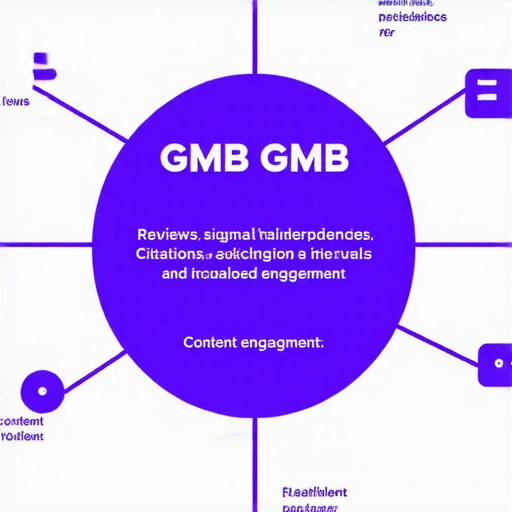
Master Local Ranking Strategies with Expert GMB Signal Repair Tips
My Journey into Local SEO and the Power of GMB Signal Repair
As someone who’s been deeply involved in local SEO for years, I vividly remember the frustration of seeing my clients’ businesses stagnate on Google Maps despite all efforts. That was until I discovered the significance of GMB signal repair and its impact on local rankings. It felt like unlocking a secret weapon that could elevate a business’s visibility in the local pack dramatically.
Understanding the Foundations of GMB Signal Repair
Over time, I learned that Google My Business (GMB) signals are the backbone of local search rankings. These signals include reviews, citations, NAP consistency, and engagement metrics. When any of these are inconsistent or corrupted, it can severely hamper local visibility. My approach has always been to first audit and clean up these signals, ensuring they are accurate and cohesive across all platforms. I found that effective GMB signal repair can significantly boost rankings, especially when combined with other proven local SEO strategies.
How to Identify and Repair Broken Signals for Better Local Rankings
One of the most impactful tactics I’ve used is a comprehensive GMB audit. Using tools like BrightLocal or Whitespark, I identify inconsistent citations, duplicate listings, and negative reviews that might be harming the local pack visibility. Once identified, I focus on cleaning up these signals—removing duplicates, correcting NAP information, and encouraging genuine reviews. This process, often called GMB signal repair, is crucial for elevating your position in local search results. For more detailed techniques, I recommend checking out this comprehensive guide.
What Are the Hidden Benefits of Consistent Signal Repair?
Beyond ranking improvements, I’ve noticed that consistent signal repair enhances trustworthiness and customer engagement. When a business’s online signals are clear and consistent, customers are more likely to trust and choose that business. Additionally, regular cleanup helps prevent issues like fake reviews or outdated information from dragging down your rankings. This proactive approach creates a solid foundation for long-term local SEO success.
Is Signal Repair the Missing Piece in Your Local SEO Strategy?
Absolutely! From my experience, many local businesses overlook the importance of signal repair, focusing instead solely on reviews or content. However, without clean and accurate signals, even the best content can fall flat in local rankings. Signal repair acts as the technical backbone, supporting all other SEO efforts. If you’re curious about expanding your local SEO toolkit, explore strategies in this resource.
If you’ve faced similar challenges or have your own tips on GMB signal repair, I’d love to hear your experiences. Drop a comment below and let’s learn from each other!
Unveiling the Secrets of Advanced GMB Signal Optimization
In my ongoing journey through local SEO, I’ve discovered that the true power lies in mastering the nuances of GMB signal repair beyond basic cleanup. It’s not just about fixing obvious issues but understanding how different signals interplay to influence your local rankings. For instance, optimizing your Google My Business (GMB) profile involves more than just accurate NAP data—it’s about aligning reviews, engagement metrics, and citation consistency to create a cohesive signal ecosystem that Google trusts.
How Do You Prioritize Signal Repair Strategies for Maximum Impact?
One challenge I often encounter is determining which signals to address first. My approach is data-driven: leveraging tools like Whitespark or BrightLocal to pinpoint the most inconsistent or damaging signals. For example, if duplicate listings are prevalent, prioritizing their removal can swiftly improve local pack visibility. Conversely, if reviews are the main issue, focusing on encouraging authentic customer feedback and managing negative reviews becomes paramount. For a comprehensive roadmap, I recommend exploring this detailed guide.
What Are the Emerging Trends in GMB Signal Repair for 2024?
As local SEO evolves, new signals and ranking factors are emerging. Voice search, for instance, is becoming more influential, requiring us to optimize for natural language queries and conversational keywords. Additionally, Google is placing increasing emphasis on user engagement metrics—such as click-through rates and time spent on your profile—which means enhancing your GMB profile with rich content, photos, and timely updates is more critical than ever. Staying ahead involves continuous monitoring and adapting your signal repair tactics accordingly. For authoritative insights, see this resource.

Visualize the interconnected signals of GMB optimization with a detailed infographic highlighting review management, citation accuracy, engagement metrics, and profile consistency.
How Can Signal Repair Be Integrated into a Holistic Local SEO Strategy?
Effective GMB signal repair acts as a foundational pillar supporting all other local SEO efforts. When signals are clean and consistent, content marketing, local link building, and review generation become more potent. For example, a well-maintained GMB profile can enhance your local pack rankings, but without supporting strategies like localized content and citation building, your overall visibility remains limited. Integrating signal repair into your broader SEO framework ensures sustained growth and resilience against ranking fluctuations. To learn more about synergizing these tactics, check out this comprehensive guide.
If you’re eager to deepen your expertise or share your success stories, please leave a comment below. Sharing insights helps the entire local SEO community thrive!
Why Are Nuances in GMB Signal Repair Critical for Advanced Local SEO?
Throughout my journey with local SEO, I’ve realized that treating GMB signal repair as a mere checklist often leads to missed opportunities. The real mastery lies in understanding the subtle interplay of signals—reviews, citations, engagement, and profile consistency—and how they influence Google’s trust. For example, a small discrepancy in NAP data across different citations might seem insignificant but can cumulatively harm your local rankings. It took me months of meticulous analysis to realize that the key to sustained success is not just fixing issues but optimizing the entire signal ecosystem to be as cohesive and trustworthy as possible.
How Do I Navigate the Complexities of Signal Interdependencies?
One of the most challenging aspects is recognizing how signals amplify each other. For instance, a well-optimized GMB profile with accurate NAP, high-quality reviews, and active engagement can significantly enhance citation authority and vice versa. I often use advanced tools like SEMrush or Moz Local to analyze these interdependencies. For example, when I improved review quality and consistency, I observed a notable jump in local pack visibility. This reinforced my belief that a holistic approach—where each signal supports the others—is essential. If you’re interested in a comprehensive approach, check out this detailed guide.
What Are the Most Overlooked Signals That Could Impact Your Rankings?
Many practitioners focus heavily on reviews and citations but overlook signals like engagement metrics—clicks, calls, and website visits—tracked through Google My Business insights. These are powerful indicators of user trust and relevance, influencing Google’s local algorithm. I once had a client whose rankings stagnated despite excellent reviews and accurate citations. After analyzing engagement data, I realized their profile lacked timely updates and rich content, which diminished user interaction. By adding photos, posts, and responding promptly to reviews, I increased engagement metrics, and rankings improved significantly. This experience taught me that optimizing for signals that foster user interaction can be a game-changer. For more insights, explore this resource.
How Can I Systematically Prioritize Signal Repair Tasks for Maximum ROI?
Prioritizing effectively requires a combination of data analysis and intuitive judgment. I start by conducting a thorough audit using tools like Whitespark or BrightLocal to identify the most inconsistent or damaging signals. For example, if duplicate GMB listings are prevalent, resolving those issues first can lead to rapid gains. Conversely, if negative reviews are dominating, focusing on review management and encouraging positive feedback takes precedence. I also keep a close eye on local ranking fluctuations to gauge the impact of each fix. This iterative approach ensures that my efforts are aligned with what moves the needle most. If you’re seeking a structured process, consider reviewing this comprehensive plan.
What Emerging Signals Should I Watch in 2024?
Voice search optimization is gaining momentum, requiring us to adapt our signal repair strategies to more natural language queries. Additionally, Google is increasingly emphasizing user engagement signals like click-through rate and dwell time, which can be influenced by rich, up-to-date content and interactive posts. I’ve started integrating more multimedia into profiles—videos, Q&A, and local news updates—to enhance engagement metrics. Staying ahead means continuously monitoring these evolving signals and adjusting your tactics accordingly. For advanced insights, I recommend reviewing this up-to-date resource.

Visualize the complex ecosystem of GMB signals with an infographic illustrating how reviews, citations, engagement, and content work together to influence local rankings, emphasizing the importance of holistic optimization.
Deciphering the Hidden Signals: What Are the Subtle Interplays That Drive Local Rankings?
In my extensive experience with local SEO, I’ve come to realize that the true mastery lies in understanding the nuanced interplay between various GMB signals. Beyond the obvious reviews and citations, factors like engagement metrics, profile consistency, and behavioral signals form a complex ecosystem that Google evaluates meticulously. For instance, optimizing your profile for rich multimedia content not only enhances user engagement but also sends positive signals that reinforce your authority. This interconnectedness is akin to tuning a finely crafted instrument: each element must harmonize to produce optimal results. Recognizing these subtle interactions enables us to craft strategies that are both sophisticated and resilient against ranking fluctuations.
How Do You Navigate and Leverage Signal Interdependencies for Maximum Impact?
Addressing the interdependent nature of signals requires a strategic, data-driven approach. I rely heavily on advanced tools like SEMrush and Moz Local to perform correlation analyses, identifying which signals most significantly influence your rankings. For example, if I notice that citation consistency correlates with improved engagement metrics, I prioritize consolidating citations before focusing on review acquisition. This layered approach ensures that efforts reinforce each other, amplifying overall impact. Additionally, staying informed about emerging trends—such as voice search optimization and AI-driven ranking factors—allows me to adapt my strategies proactively. For further insights, I recommend exploring this comprehensive resource that delves into holistic signal optimization techniques.
How Can I Systematically Integrate Advanced Signal Repair Tactics into My Broader SEO Framework?
Integrating sophisticated signal repair seamlessly into a broader SEO strategy involves establishing a continuous monitoring and iteration cycle. I start with detailed audits to identify weak points, followed by targeted interventions like citation cleanups, review management, and profile enhancements. These efforts are then measured against key performance indicators such as local pack rankings and user engagement metrics. Regularly revisiting and refining these tactics ensures that your signals remain cohesive and trustworthy. Personally, I’ve found that aligning signal repair with content marketing and local link building creates a synergistic effect, elevating overall visibility. For a structured approach, see this detailed guide.
Things I Wish I Knew Earlier (or You Might Find Surprising)
1. The Power of Small Details
In my early days of local SEO, I underestimated how tiny inconsistencies in NAP data or review responses could significantly impact rankings. It’s like tuning a musical instrument; every string needs to be perfectly calibrated. Over time, I realized that paying attention to these subtle signals can unlock better visibility than some of the more obvious tactics.
2. The Interplay of Signals
Initially, I thought fixing reviews or citations alone would suffice. But I discovered that these signals are interconnected—improving one often amplifies the effect of others. For instance, consolidating citations can boost review trustworthiness, which in turn enhances engagement metrics.
3. The Hidden Role of Engagement Metrics
Engagement signals like clicks, calls, and time spent on profile are underrated. I once optimized a profile with perfect reviews and citations, but neglecting engagement led to stagnation. Incorporating rich content and timely updates made a noticeable difference.
4. The Evolving Nature of Signals in 2024
Voice search and AI-driven ranking factors are reshaping how signals work. Adapting to these trends by optimizing for natural language and providing multimedia content is crucial for staying ahead.
Resources I’ve Come to Trust Over Time
- BrightLocal: This tool has been invaluable for audits and tracking local signals. Its comprehensive reports helped me identify hidden issues I might have missed.
- Whitespark: Their citation building and cleanup tools are top-notch, making it easier to correct inconsistencies that harm rankings.
- Google’s Official Guidelines: Staying updated with Google’s own resources ensures my strategies align with current best practices. I recommend regularly reviewing their documentation to avoid out-of-date tactics.
- GMBExorcist Blog: This resource offers practical, real-world tips on signal repair and local SEO, which I’ve found directly applicable to my work.
Parting Thoughts from My Perspective
Mastering GMB signal repair is a journey of continuous learning and adaptation. The most valuable takeaway is that small, consistent improvements across all signals create a solid foundation for local SEO success. Don’t overlook the nuanced interplay of reviews, citations, and engagement—these are the building blocks of trustworthiness in Google’s eyes. If you’re serious about boosting your local rankings, I encourage you to integrate comprehensive signal repair into your strategy and stay updated with emerging trends. And if this article resonated with you, I’d love to hear your experiences or tips. Feel free to share in the comments or pass it along to someone who might benefit from it. Remember, the key to long-term success is persistence and attention to detail—happy optimizing!”,




